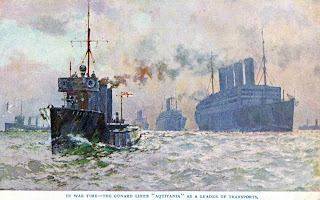On the minesweeper “June Rose”, our job was to patrol off the coast, from the Tyne to the Humber, which formed part of the East Coast Convoy Route, known as the ‘War Channel'. Those minesweepers based at Grimsby patrolled the War Channel south of us.
 |
| War Channel: Tyne to Humber |
Extract From “Out Sweeps “ by Paul Lund and Harry Ludlam:
“The Grimsby force’s sweeping area extended from the Humber Lightvessel…south to Sheringham Norfolk. The War Channels were marked by lighted buoys placed at intervals of five mile apart. This may seem ridiculous – showing the enemy exactly where to lay his mines – but in fact the channels were searched each day before the ships and convoys used them and the object of the mine-laying was defeated; for the presence of any mines then became known and convoys could either be diverted round the minefield or swept through it by minesweepers clearing a path for them”
 |
| North Sea Convoy in World War II |
“June Rose’s” war service was mostly patrolling at night, keeping watch on the convoys as well as traffic using Newcastle.
Before we left North Shields in the afternoon, we picked up a barrage balloon from the quay then when we were clear of the pier heads we let it go higher from the winch that was mounted on the galley top.
 |
| Entrance and Pier Head of the River Tyne |
We did four nights at sea and two off.
You heard that minesweepers had been lost – as time went on it affected the older crewmen more than us youngsters.
When a mine exploded close to “June Rose” the stern gear, rudder, prop. and shaft, was damaged and we got a fortnight’s shore leave while she was in dry dock.
 |
| Minesweeper in Dry Dock |
If “June Rose” had foundered and there were survivors, our best hope was to be saved by a local lifeboat – a slim chance in the war. There were about a dozen lifeboat stations along the route we patrolled, these included Whitby and Flamborough.
 |
|
Whitby Lifeboat, 1938 -1974: “Mary
Ann Hepworth”
372 Launches, 201 Lives Saved |
 |
|
Flamborough Lifeboat, 1934-1948:
“Elizabeth and Albina Whitley”
33 Launches, 77 Lives and 5 Vessels Saved. |
I had a wire pierce my hand while putting the sweep out and when we got back to North Shields, I went to the sick bay. I was kept in and sent to Newcastle Royal Infirmary for a small operation on my hand, then two weeks excused duty and sent to Berwick-on-Tweed for two weeks. It turned out to be an abscess in the palm of the hand, and I was granted a “hurt certificate”.
In early 1944, after fifteen months at North Shields, we left towing our skid sweep; bound for Portsmouth via Grimsby, Lowestoft, Dover and Newhaven.
I had a few months at Portsmouth on the “June Rose”. The build-up to D-Day of ships, troops and equipment at Pompey was something I shall never forget – it never stopped day and night.
On D-Day itself, “June Rose” was diverted from sweeping the Normandy Invasion Channel, to go to Southampton Water to sweep the channel for a “large liner” carrying thousands of American troops.
 |
| RMS "Aquitania" |
Two weeks leave to prepare for overseas then back to Lowestoft for a train to the troopship at Liverpool.